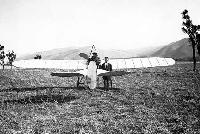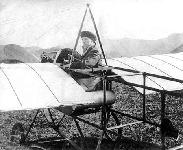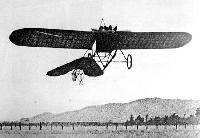Форум Breguet's Aircraft Challenge
NEARLY 10 years after the Wright Brothers made history with the first sustained controlled powered flight, a young Wellington man was making aviation history in some paddocks east of Carterton.
Percy Fisher's monoplane is the subject of a new book, entitled Taking Flight, written by the aviation pioneer's great-grandson Paul Maxim. It tells the story of how some of New Zealand's aviation history took place some 10km east of Carterton, near Gladstone.
Mr Maxim says he was always aware that a relative of his had built and flown an aeroplane early last century, but he hadn't realised the historical significance of it. " I remember telling my son Simon, who was about 7 at the time, about my great-grandfather's exploits. He had so many questions and it was that which sparked my interest in finding out more." The rest, as they say is history.
Here is the story of one of New Zealand's pioneering aviators.
David Percival Fisher, who at an early age became known as Percy, was born in Wellington's Ghuznee Street on July 9, 1882. The third of seven children, he was the son of David and Christina Fisher. In 1897, aged 15, he began a seven-year engineering apprenticeship with New Zealand Railways and served his time as a turner in the locomotive branch in the Petone workshops.
In June 1902, aged 19, he and two other Wellington engineers took out a patent on "an improved method of and means for ventilating halls, theatres and other places of resort". The ventilation plant was later installed in the Theatre Royal but the young designers got caught up in a legal wrangle over payment. Another patent the next year involved "an improved peg".
In 1904 Percy left the Railways and became a mechanical engineer, setting up a workshop repairing gramophones, using his own designed and patented parts. During the winter of 1910 he met photographer Arthur Schaef, an aviator buff who had been inspired by news of aviation success overseas, and who was building the first of two monoplanes.
On August 20, 1910 the Vogel was taken to the Hutt Park Raceway, and Percy joined Schaef's team as a enthusiastic volunteer at that first trial. During the trial the carburettor failed to work properly, and the engine proved unsuitable. Percy spent the next three months working on the engine, virtually rebuilding it from scratch. The newly-built motor, when finished, was considered an engineering feat and expected to deliver 30-horse power.
In January 1911 the "new" Vogel was taken to Lyall Bay and over a six-week period attempts to get it up in the air proved fruitless. Finally, on March 6, the Vogel had its most successful trial, leaving the ground for 50m and getting to a height of about 5m. This hop marked the beginning of heavier-than-air flight in Wellington.
At the end of May 1911, Percy and Schaef discontinued working together, preferring to embark on separate aviation projects during the next 18 months. Work on Fisher's monoplane began the next month, with his new aeroplane being built in an upper storey room in present-day Bond Street, across the stairwell from Schaef's premises. According to Mr Maxim, the aeroplane was essentially a Bleriot type, a proven performer since its designer Louis Bleriot had flown his own 24 horsepower monoplane across the British Channel two years earlier.
Says Mr Maxim: "Fisher used a drawing of that Bleriot model, known as the Mark X1, from Flight magazine, as the basis for his design. But in doing so Percy Fisher made several notable changes. " In an attempt to reduce drag the fuselage was given a rounded bonnet nose, constructed from three-ply wood. The tail and back rudders were enlarged and reshaped and the landing carriage altered to two front wheels on either side of a landing skid, the wheels especially made to absorb jarring. " Another sprung skid was fitted to the rear of the fuselage to take the weight of the tail section." The fuselage frame was made from timber, most likely cedar, which was neatly scarfed at the joints and secured with metal clips and a bolt, while the vertical struts were spokeshaved to enhance streamlining. Cross-wire bracing ensured the frame did not distort under pressure. The wings, rudder and elevator fabrication consisted of Japanese silk sewn over a wooden frame which was varnished to stiffen and seal. Bamboo struts were then tacked over to secure the fabric to the frame. The detachable wings were braced with wires attached to a central tripod. The first laminated wooden propeller, which was also made by Percy, was 2.057m long and capable of 1200 revolutions a minute. The only thing that Percy did not make was his engine's aluminium crankcase, which came from Schaef's old imported engine. Other statistics include: Length 7.62m, span 7.92m, wing area 11.27m squared, tail area 5.39m squared, weight 196.9kg, horsepower 40.
The aeroplane was finally finished in November 1912. Realising that Wellington was not the best place to test his creation, Percy opted for Pigeon Bush, near Featherston. In December that year the aeroplane was railed over the Rimutakas before being taken to the flats of Pigeon Bush Station.
On Wednesday, December 25, Fisher attempted his first flight. The Wairarapa Age reported: "Four held it, while one got into the flyer's seat. The motor was started, and worked so well that the four men could not hold the machine, which bolted, rising some 30 feet. It travelled some distance, when something happened and it came down suddenly. " The plucky new-chum aviator sustained an injury, which we understand is not serious, to one of his legs. It was demonstrated, however, that the machine would fly, and possibly after a few more trials it will be seen circling over the Wairarapa towns, the pioneer of its kind in this part of the world."
In April the next year, after a series of trials, Percy decided to hand over the pilot duties to Reggie White. Their perseverance was to pay off, because on April 28 five brief hops were achieved and the success was reported in the Dominion the next day. " The five flights were each of about 200 yards, and were made at an elevation of from 20 to 30 feet. The machine is stated to have behaved admirably, and to have proved its stability. If the weather is fair it is hoped to make a more extensive flight today. Mr White, who made yesterday's flights, is gaining his first experiences as an aviator."
In June 1913, after five months of trials at Pigeon Bush, a decision was made to shift operations to Carterton where the wind was more suitable for flying and the ground less rough.
Although farmer and timber merchant W. Howard Booth gave Percy and his team the use of a paddock behind his sawmill, the first flight did not take place in Carterton itself.
While the weather forecast for the weekend of June 21-22 was for fair conditions, on arrival on the Saturday morning Percy was met by overcast weather and blustery conditions. A decision was made to hold the trial at Hurunui-O-Rangi Flat, near Gladstone, on land owned by Leonard Pike.
According to Mr Maxim, the plane was towed out to Hurunui-o-rangi behind an Austin 15 (hp) car. During that weekend the plane was put through its most public trial in the time it had first come to Wairarapa. " The Saturday was the best of the three days. Reports suggest that the monoplane attempted eight flights and got into the air seven times. " With the 'tricky wind puffs' only straight runs were made and the plane reportedly averaged something like 18m in height, and covered at least 800m in successive efforts. " There were unpleasant southerly conditions on Sunday and Monday, but the plane managed three flights on the first day and two more on the second," Mr Maxim writes.
A report in the Evening Post, dated June 24, said: "The pilot of the Fisher monoplane, who has to learn for himself how to manipulate the controls, told a Post representative today that the machine is very amendable to direction. " So far no attempt has been made to turn in the air - the flights have all been in straight lines - but Mr White has no doubts as to the balance of the monoplane. " On one occasion when he essayed to descend, and switched off the engine, he found that the head wind simply lifted him some 20 feet into the air again. " The engine is working very satisfactorily, and it was calculated by observers that at times the monoplane was doing over 40 miles an hour. She can leave the ground in 30 yards or so."
The historic moments were captured on film by Wellington cinematographer Charlie Barton, who managed to shoot about 100m of film. This was quickly edited into a short feature film, entitled Experimental Flights of the Fisher Monoplane, lasting about three minutes. It premiered as a trailer at the People's Picture Palace cinema during the week of July 4-10 to "standing room only" crowds.
Mr Maxim says the film included a small clip from Pigeon Bush showing Percy and White with the plane, followed by eight segments of the plane taking off and in the air at Middle Run in Gladstone. " There was considerable public interest in viewing the first aeroplane in New Zealand to be captured in flight on moving film and it was progressively shown in other parts of the country. " It was seen in Wairarapa at Masterton's TP Electric Theatre for five days at the end of July."
According to Mr Maxim's book, further Fisher Monoplane flights were promised after the Middle Run success in June but it seems no more were made at Gladstone. During the spring and summer of 1913-1914 Percy journeyed to Carterton for further flights in paddocks before the aeroplane was railed back to Wellington at the end of that summer for display at a festival in Wellington.
By early 1916 the Fisher monoplane had run its course as an aircraft and it was sold to John Burgess, an engineer living in Gisborne. Soon after Burgess joined the armed forces, and his business as well as the aeroplane was sold to A.J. Cox. Cox was interested in aviation and had hoped to test the flying capacity of the machine himself. But on hearing the aeroplane had been involved in several crashes he decided not to risk flying and the plane was strung up in the rafters for some years. Eventually, when space became a concern, Cox had the machine dismantled. Percy Fisher moved away from aviation to concentrate on his engineering business. His company D.P. Fisher Ltd became one of New Zealand's largest and most innovative engineering establishments.
Percy Fisher designed many patented inventions, most notably the Fisher Piston Ring which was sold worldwide.
He died in 1941. D.P. Fisher Ltd lasted until 1956 when it was sold to Repco, who were expanding into New Zealand.





